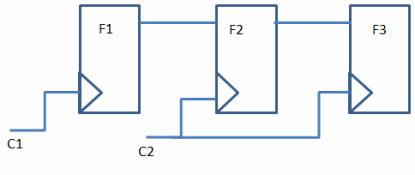Handling Asynchronous Clock Groups in SDC
Sanjay Churiwala & Balachander Krishnamurthy, Xilinx
EETimes (11/15/2013 04:40 PM EST)
Introducing CDC
Most SoC designs in today's world employ multiple clocks and commonly have many clock domains. As data crosses from one clock domain to another within the design, the potential for metastability problems arises due to asynchronous clock domain crossings (CDCs).

Figure 1: An asynchronous crossing with simple double flop synchronization.
In Figure 1, there is an asynchronous CDC for the data going from flop F1 (clocked by C1) into F2 (clocked by C2), assuming that C1 and C2 are asynchronous with respect to each other.
To read the full article, click here
Related Semiconductor IP
- Hardware Security Module (HSM) for AMD Xilinx Versal ACAP device
- Hardware Security Module (HSM) for Xilinx Zynq UltraScale+ MPSoC platform
- ARC4 Core for Xilinx FPG
- Xilinx Virtual Cable
- Xilinx HMC Controller
Related Articles
- Asynchronous Logic: large CMOS devices without a clock tree
- Verifying Dynamic Clock switching in Power-Critical SoCs
- Ultra Low Power Designs Using Asynchronous Design Techniques (Welcome to the World Without Clocks)
- High-Performance DSPs -> DSP performance: Useful work per clock tick
Latest Articles
- A 14ns-Latency 9Gb/s 0.44mm² 62pJ/b Short-Blocklength LDPC Decoder ASIC in 22FDX
- Pipeline Stage Resolved Timing Characterization of FPGA and ASIC Implementations of a RISC V Processor
- Lyra: A Hardware-Accelerated RISC-V Verification Framework with Generative Model-Based Processor Fuzzing
- Leveraging FPGAs for Homomorphic Matrix-Vector Multiplication in Oblivious Message Retrieval
- Extending and Accelerating Inner Product Masking with Fault Detection via Instruction Set Extension